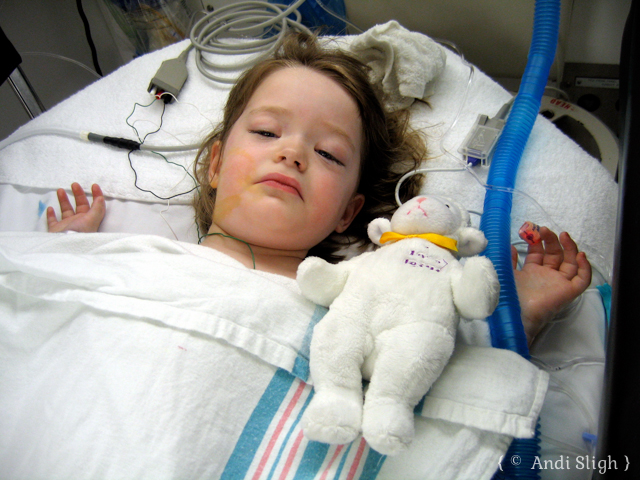
Ten years ago, in early January of 2006, Sarah Kate underwent selective dorsal rhizotomy (SDR) surgery just one week after her third birthday. If you aren’t familiar with SDR, here’s the way I summarized it previously: a neurosurgeon tests sensory nerve rootlets that control the legs to see which ones are “misfiring” and then permanently cuts the most severe of them, permanently disconnecting those wrong signals to the legs. Some spasticity will remain, because not all of the wacky nerves can be cut, but the amount varies from person to person.
I wrote a post about our experience with SDR back in 2014; it answered questions that I am commonly asked by parents who are contemplating it for their child. Today I’d like to wade into the more philosophical aspects – what we thought we knew then and what we actually see in retrospect.
What We Thought We Knew Then
Before Sarah Kate’s SDR (and, in some cases, for a little while after), we believed a lot of things about it. Many of those were, if not wrong, at least naive. If your child has had SDR (or it’s been recommended for your child), you may see yourself in some of these thoughts.
- We wished she could be the one to make the decision whether to have the surgery. It was such a huge decision and she was so, so tiny at the time. When we committed to the procedure, she was still two and a very tiny two, at that. Choosing surgery that wasn’t necessary for survival and would drastically change her body seemed too big a decision for us to make without her input. Now that she’s older, I have no doubt she would have jumped at the chance, but then? We just didn’t know.
- We thought she would avoid any future major procedures. I admit, no one ever told us she would be done after SDR – the most we were told is that she would likely have fewer procedures, and likely not until she was older (i.e., puberty era). I optimistically chose to believe she’d be able to escape them. As it turned out, they were right and I was disappointed. She had major surgery almost two years ago that you can read more about here.
- We thought she wouldn’t lose any of the skills she gained as a result of the SDR. We were wrong. In the fall of 2013, Sarah Kate hit the big growth spurt associated with puberty (the one the doctors and therapists accurately predicted in 2006) and the wheels came off. The major orthopedic procedure I thought she’d be able to avoid hit us like a freight train. This April, we reach the two-year mark and Sarah Kate still isn’t back to where she was in mid-2013.
- We thought she wouldn’t progress much after the first year following SDR. Fortunately, I was way off on that one. Sarah Kate continued to make progress right up through the middle of 2013, seven years after the SDR. It came in spurts after long plateaus, but it came nonetheless. I don’t know if that will continue, but I hope it does for at least long enough to get her back to her previous high point in 2013. If it doesn’t, it will be fine, but it can be frustrating to lose a skill that you previously had – and worked so hard to achieve.
- We worried that the surgery would fundamentally change her. It seems crazy in hindsight, but I thought that if her struggle to walk was greatly lessened, that she wouldn’t be as tough anymore. My fears were unfounded, of course, as I wrote in this post three years ago. She’s the same kid, and she still struggles.
What We See In Retrospect Ten Years Later
Would we do it again? Absolutely. We have no regrets. Looking back, I can see that I didn’t truly grasp Sarah Kate’s limitations at the time. I had not accepted that she might not ever walk independently, and I foolishly viewed walking as the be-all end-all of ambulation, when walking is actually just one step along the developmental journey. You have to walk before you can climb stairs or jump or run. Walking in a straight line on a flat, even surface is a lot easier than walking uphill or stepping up on a curb or even, in Sarah Kate’s case, standing still. Being able to take a few independent steps across the living room is a long way from being able to spend a day exploring Universal Studios without a wheelchair. I’m not sure if I truly didn’t understand the progression then, or if I just chose not to think about it. I suspect the latter.
I don’t feel guilty for not accepting those things. We were learning a new paradigm, incrementally through experience, in part because there were no concrete answers, and in part because we believed our kid would be The One Who Beat Expectations. She did, of course, but not in the way we imagined back then. In some respects, I appreciate our naiveté. I think it would have been hard to look ahead if we’d known what the reality would be. It’s like how I’m thankful we didn’t know Nathan had Down syndrome before he was born; when he arrived, we worried but at the same time he was wonderful and we just handled it, whereas if we’d known beforehand we’d have had all of the worry and none of the wonderful baby squishiness.
Mr. Andi and I agree: Sarah Kate probably would not have walked independently without the SDR. Softball, swimming, and show choir would have been, if not impossible, certainly a lot less likely, and the growth spurt she had in 2013 might have led her to rely almost exclusively on a wheelchair.** I’m not saying that her life would have been “worse” if we had chosen a different path, mind you – her life would have been her life and she would have been okay. But I am glad she got to experience things like softball, swim team, and show choir, and I think she is, too.
That’s my take on things one decade later. Questions? Fire away!
Resources about SDR available on Bringing the Sunshine:
Our Experience with Selective Dorsal Rhizotomy, the post referenced above, covered a number of questions I commonly receive about SDR, such as:
How old was Sarah Kate when she had it done?
What was she able to do/not do before/after?
Where was it done/who did it? Why did you go there instead of (fill in the blank)?
What was the recovery like?
How much physical therapy rehab was required? What did they do?
How quickly did you see a difference?
Did your insurance cover it?
For a video showing Sarah Kate’s progression from before the SDR up until the summer of 2013, visit my YouTube channel.
For a blow-by-blow of the SDR experience from beginning to end, visit the blog that I kept for family and friends back in 2006.
** A note about wheelchairs: We love hers! Although they can be a disadvantage sometimes, they also provide a degree of freedom that is invaluable. I can’t imagine what it would have been like to navigate Universal Studios without it – with it, she could maneuver quickly, squeeze into tight spaces, avoid fatigue, and just enjoy the experience. A good wheelchair is a godsend, no kidding. And hers is pretty sharp looking, too. 😉
UPDATE (3/7/2016): Sarah Perkins has written her own post about SDR 30 years later, from her perspective as the patient. Go check it out.

You have one brave, feisty little miracle girl. I’m sure you are so proud.